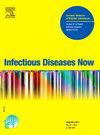New epidemio-clinical insights into cutaneous leishmaniasis caused by Leishmania infantum in Casablanca, Morocco
IF 2.2
4区 医学
Q2 INFECTIOUS DISEASES
引用次数: 0
Abstract
Background
Cutaneous leishmaniasis (CL) represents a global public health challenge. In Morocco, the disease raises several concerns, such as geographical expansion, clinical heterogeneity, and the emergence of new Leishmania species. Our objective was to describe a new epidemiological and clinical profile caused by Leishmania infantum in patients diagnosed in Casablanca, Morocco.
Methods
We performed a cross-sectional study from 2012 to 2023. Epidemiological and clinical data were collected from patients meeting the inclusion criteria using a standardized clinical and epidemiological data collection tool. Parasitological and molecular analyses were performed on samples obtained from each patient. Only patients with confirmed positive polymerase chain reaction (PCR) and genotyping results were included in the study.
Results
PCR identified L. infantum as the causative agent of CL in 20 patients, who were predominantly female and from various rural regions across Morocco. All patients resided in areas characterized by inadequate sanitation and the presence of stray dogs. Clinical presentations were diverse, with the papulonodular form being the most frequently observed. Parasitological examinations yielded positive results in 70% of cases.
Conclusions
This study underscores the emergence of CL due to L. infantum as a growing public health concern in Morocco. It highlights the urgent need for enhanced awareness, targeted surveillance, preventive measures to mitigate the spread of the disease, and therapeutic strategies that consider its visceralizing potential.
摩洛哥卡萨布兰卡由婴儿利什曼原虫引起的皮肤利什曼病的流行病学-临床新见解。
背景:皮肤利什曼病(CL)是一个全球性的公共卫生挑战。在摩洛哥,该病引起了若干关切,如地理扩展、临床异质性和出现新的利什曼原虫物种。我们的目的是描述在摩洛哥卡萨布兰卡诊断的患者中由婴儿利什曼原虫引起的新的流行病学和临床概况。方法:我们从2012年到2023年进行了一项横断面研究。采用标准化的临床和流行病学资料收集工具收集符合纳入标准的患者的流行病学和临床资料。对每位患者的样本进行了寄生虫学和分子分析。只有证实聚合酶链反应(PCR)阳性和基因分型结果阳性的患者才被纳入研究。结果:PCR鉴定婴儿乳杆菌为20例患者CL的病原体,这些患者主要是女性,来自摩洛哥各个农村地区。所有病人都居住在卫生条件不佳和流浪狗出没的地区。临床表现多样,最常见的是丘疹样。70%病例的寄生虫学检查呈阳性。结论:本研究强调了由于乳酸菌引起的CL的出现是摩洛哥日益关注的公共卫生问题。它强调迫切需要加强认识、有针对性的监测、预防措施以减轻疾病的传播,以及考虑到其内脏化潜力的治疗战略。
本文章由计算机程序翻译,如有差异,请以英文原文为准。
求助全文
约1分钟内获得全文
求助全文
来源期刊

Infectious diseases now
Medicine-Infectious Diseases
CiteScore
7.10
自引率
2.90%
发文量
116
审稿时长
40 days
 求助内容:
求助内容: 应助结果提醒方式:
应助结果提醒方式:


